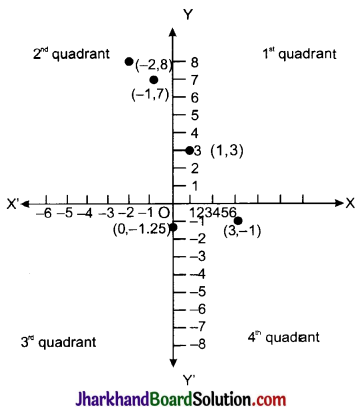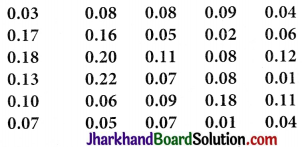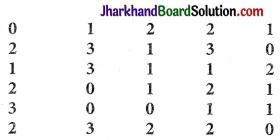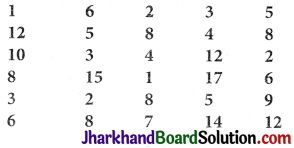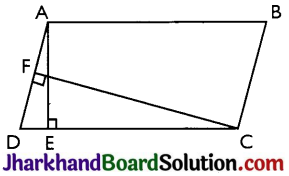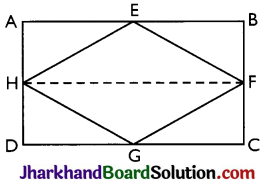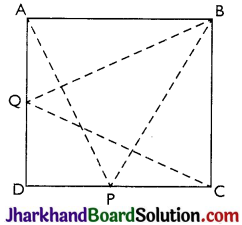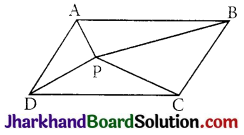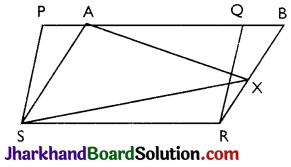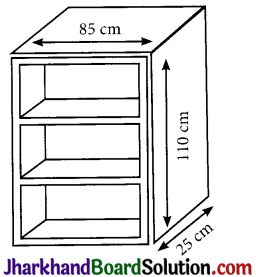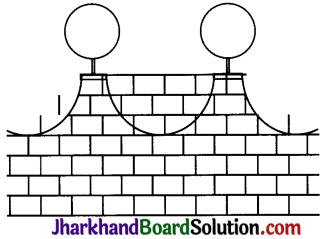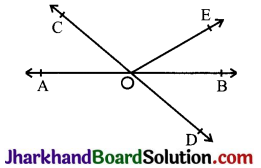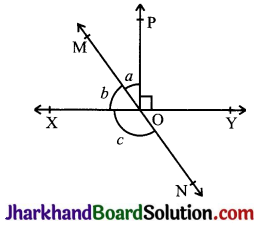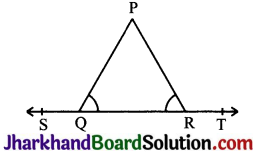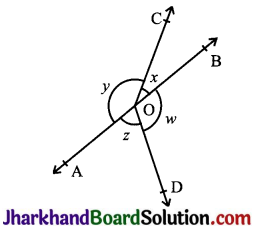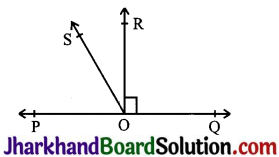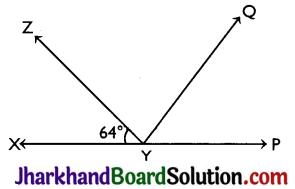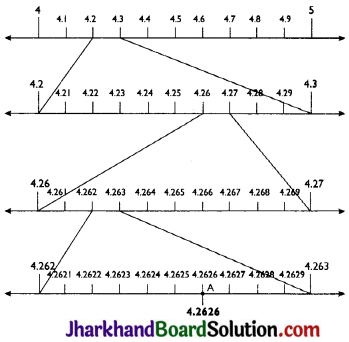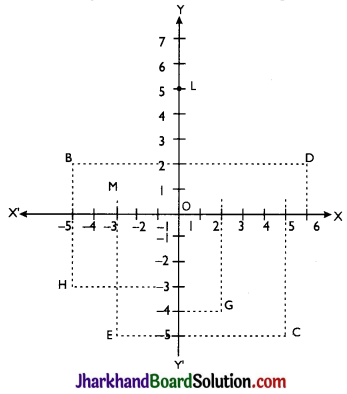Jharkhand Board JAC Class 9 Maths Solutions Chapter 2 Polynomials Ex 2.5 Textbook Exercise Questions and Answers.
JAC Board Class 9th Maths Solutions Chapter 2 Polynomials Ex 2.5
Question 1.
Use suitable identities to find the following products:
(i) (x + 4) (x + 10)
(ii) (x + 8) (x – 10)
(iii) (3x + 4) (3x – 5)
(iv) (y2 + 3/2) (y2 – 3/2)
(v) (3 – 2x) (3 + 2x)
Answer:
(i) Using identity, (x + a) (x + b)
= x2 + (a + b) x + ab
In (x + 4) (x + 10), a = 4 and b = 10
Now,
(x + 4) (x + 10)
= x2 + (4 + 10)x + (4 × 10)
= x2 + 14x+ 40
(ii) (x + 8) (x – 10)
Using identity, (x + a) (x + b)
= x2 + (a + b) x + ab
Here, a = 8 and b = -10
(x + 8) (x – 10)
= x2 + {8 + (- 10)}x + {8 × (- 10)}
= x2 + (8 – 10)x – 80
= x2 – 2x – 80
(iii) (3x + 4) (3x – 5)
Using identity, (x + a) (x + b)
= x2 + (a + b) x + ab
Here, x as 3x, a = 4 and b = – 5
(3x + 4) (3x – 5)
= (3x)2 + {4 + (-5)}3x + {4 × (-5)}
= 9x2 + 3x(4 – 5) – 20
= 9x2 – 3x – 20
(iv) (y2 + 3/2) (y2 – 3/2)
Using identity, (x + y) (x – y) = x2 – y2
Here, x = y2 and y = 3/2
(y2 + 3/2) (y2 – 3/2)
= (y2)2 – (3/2)2
= y4 – 9/4
(v) (3 – 2x) (3 + 2x)
Using identity, (x + y) (x – y) = x2 – y2
Here, x = 3 and y = 2x
(3 – 2x) (3 + 2x)
= 32 – (2x)2
= 9 – 4x2

Question 2.
Evaluate the following products without multiplying directly:
(i) 103 × 107
(ii) 95 × 96
(iii) 104 × 96
Answer:
(i) 103 × 107
Answer:
(i) 103 × 107 = (100 + 3) (100 + 7)
Using identity, (x + a) (x + b)
= x2 + (a + b) x + ab
Here, x = 100, a = 3 and b = 7
103 × 107 = (100 + 3) (100 + 7)
= (100)2+ (3 + 7)100 + (3 × 7)
= 10000 + 1000 + 21 = 11021
(ii) 95 × 96 = (90 + 5) (90 + 6)
Using identity, (x + a) (x + b)
= x2 + (a + b) x + ab
Here, x = 90, a = 5 and b = 6
95 × 96 = (90 + 5) (90 + 6)
= 902 + 90(5 + 6) + (5 × 6)
= 8100 + (11 × 90) + 30 = 8100 + 990 + 30 = 9120
(iii) 104 × 96 = (100 + 4) (100 – 4)
Using identity, (x + y) (x – y) = x2 – y2
Here, x = 100 and y = 4
104 × 96 = (100 + 4) (100 – 4)
= (100)2 – (4)2
= 10000 – 16 = 9984
Question 3.
Factorise the following using appropriate identities:
(i) 9x2 + 6xy + y2
(ii) 4y2 – 4y + 1
(iii) x2 – \(\frac{y^2}{100}\)
Answer:
(i) 9x2 + 6xy + y2
= (3x)2 + (2 × 3x × y) + y2
Using identity, (a + b)2 = a2 + 2ab + b2
Here, a = 3x and b = y
9x2 + 6xy + y2
= (3x)2 + (2 × 3x × y) + y2
= (3x + y)2
= (3x + y) (3x + y)
(ii) 4y2 – 4y + 1
= (2y)2 – (2 × 2y × 1) + 12
Using identity, (a – b)2 = a2 – 2ab + b2
Here, a = 2y and b = 1
4y2 – 4y + 1
= (2y)2 – (2 × 2y × 1) + 12
= (2y – 1)2
= (2y – 1) (2y – 1)
(iii) x2 – \(\frac{y^2}{100}\) = x2– (\(\frac{y}{10}\))2
Using identity, a2 – b2= (a + b) (a – b)
Here, a = x and b = (\(\frac{y}{10}\))
x2 – \(\frac{y^2}{100}\) = x2 – (\(\frac{y^2}{100}\))2
= (x – \(\frac{y}{10}\)) (x + \(\frac{y}{10}\))

Page – 49
Question 4.
Expand each of the following, using suitable identities:
(i) (x + 2y + 4z)2
(ii) (2x – y + z)2
(iii) (-2x + 3y + 2z)2
(iv) (3a – 7b – c)2
(v) (-2x + 5y – 3z)2
(vi) [\(\frac{1}{4}\) a – \(\frac{1}{2}\) b + 1]2
Answer:
(i) (x + 2y + 4z)2
Using identity, (a + b + c)2 = a2 + b2 + c2 + 2ab + 2bc + 2ca
Here, a = x, b = 2y and c = 4z
(x + 2y + 4z)2
= x2 + (2y)2 + (4z)2 + (2 × x × 2y) + (2 × 2y × 4z) + (2 × 4z × x)
= x2 + 4y2 + 16z2 + 4xy + 16yz + 8xz
(ii) (2x – y + z)2
Using identity, (a + b + c)2 = a2 + b2 + c2 + 2ab + 2bc + 2ca
Here, a = 2x, b = – y and c = z
(2x – y + z)2
= (2x)2 + (-y)2 + z2 + (2 × 2x × (- y)) + (2 × (- y) × z) + (2 × z × 2x)
= 4x2 + y2 + z2 – 4xy – 2yz + 4xz
(iii) (-2x + 3y + 2z)2
Using identity, (a + b + c)2 = a2 + b2 + c2 + 2ab + 2bc + 2ca
Here, a = – 2x, b = 3y and c = 2z
(-2x + 3y + 2z)2
=(-2x)2 + (3y)2 + (2z)2 + (2 × (- 2x) × 3y) + (2 × 3y × 2z) + (2 × 2z × (- 2x))
= 4x2 + 9y2 + 4z2 – 12xy + 12yz – 8xz
(iv) (3a – 7b – c)2
Using identity, (a + b + c)2 = a2 + b2+ c2 + 2ab + 2bc + 2ca
Here, a = 3a, b = – 7b and c = – c
(3a – 7b – c)2
= (3a)2 + (-7b)2 + (-c)2 + (2 × 3a × (-7b)) + (2 × (- 7b) × (- c)) + (2 × (- c) × 3a)
= 9a2 + 49b2 + c2 – 42ab + 14bc – 6ac
(v) (-2x + 5y – 3z)2
Using identity, (a + b + c)2 = a2 + b2 + c2 + 2ab + 2bc + 2ca
Here, a = – 2x, b = 5y and c = – 3z
(-2x + 5y – 3z)2
= (-2x)2 + (5y)2 + (-3z)2 + (2 × (-2x) × 5y) + (2 × 5y × (- 3z)) + (2 × (- 3z) × (- 2x))
= 4x2 + 25y2 + 9z2 – 20xy – 30yz + 12xz
(vi) [\(\frac{1}{4}\) a – \(\frac{1}{2}\) b + 1]2
Using identity, (a + b + c)2 = a2 + b2 + c2 + 2ab + 2bc + 2ca
Here, a = \(\frac{1}{4}\)a; b = \(\frac{1}{2}\) and c = 1
[\(\frac{1}{4}\) a – \(\frac{1}{2}\) b + 1]2
= \(\left(\frac{1}{4} \mathrm{a}\right)^2+\left(-\frac{1}{2} \mathrm{~b}\right)^2+1^2+\left(2 \times \frac{1}{4} \mathrm{a} \times \frac{(-1)}{2} \mathrm{~b}\right)+\left(2 \times \frac{(-1)}{2} \mathrm{~b} \times 1\right)+\left(2 \times 1 \times \frac{1}{4} \mathrm{a}\right)\)
= \(\frac{1}{16} \mathrm{a}^2+\frac{1}{4} \mathrm{~b}^2+1-\frac{1}{4} \mathrm{ab}-\mathrm{b}+\frac{1}{2} \mathrm{a}\)

Question 5.
Factorise:
(i) 4x2 + 9y2 + 16z2 + 12xy – 24yz – 16xz
(ii) 2x2 + y2 + 8z2 – 2\( \sqrt{2} \)xy + 4 \( \sqrt{2} \) yz – 8xz
Answer:
(i) 4x2 + 9y2 + 16z2 + 12xy – 24yz -16xz
Using identity, (a + b + c)2 = a2 + b2 + c2 + 2ab + 2bc + 2ca
4x2 + 9y2 + 16z2 + 12xy – 24yz – 16xz
= (2x)2 + (3y)2 + (-4z)2 + (2 × 2x × 3y) + (2 × 3y × (- 4z)) + (2 × (- 4z) × 2x)
= (2x + 3y – 4z)2 = (2x + 3y – 4z) (2x + 3y – 4z)
(ii) 2x2 + y2 + 8z2 – 2 \( \sqrt{2} \) xy + 4 \( \sqrt{2} \) yz – 8xz
Using identity, (a + b + c)2 = a2 + b2 + c2 + 2ab + 2bc + 2ca
2×2 + y2 + 8z2 – 2 \( \sqrt{2} \) xy + 4 \( \sqrt{2} \) yz – 8xz
= (-\( \sqrt{2} \) x)2 + (y)2 + (2\( \sqrt{2} \)z)2 + (2 × (- \( \sqrt{2} \) x) × y) + (2 × y × 2 \( \sqrt{2} \) z) + (2 × 2\( \sqrt{2} \) z × (- \( \sqrt{2} \)x))
= (-V/2x + y+ 2>/2z)2 = (-V2x + y + 2 \( \sqrt{2} \) z) (- \( \sqrt{2} \) x + y + 2 \( \sqrt{2} \) z)
Question 6.
Write the following cubes in expanded form:
(i) (2x + 1)3
(ii) (2a – 3b)3
(iii) \(\left[\frac{3}{2} x+1\right]^3\)
(iv) \(\left[x-\frac{2}{3} y\right]^3\)
Answer:
(i) (2x + 1)3
Using identity, (a + b)3 = a3 + b3 + 3ab(a + b)
(2x+1)3 = (2x)3 + 13 + (3 × 2x × 1)(2x + 1) = 8x3 + 1 + 6x(2x + 1)
= 8x3 + 12x2 + 6x + 1
(ii) (2a – 3b)3
Using identity, (a – b)3 = a3 – b3 – 3ab(a – b)
(2a – 3b)3
= (2a)3 – (3b)3 – (3 × 2a × 3b)(2a – 3b) = 8a3 – 27b3 – 18ab(2a – 3b)
= 8a3 – 27b3 – 36a2b + 54ab2
(iii) \(\left[\frac{3}{2} x+1\right]^3\)
Using identity, (a – b)3 = a3 – b3 – 3ab(a – b)
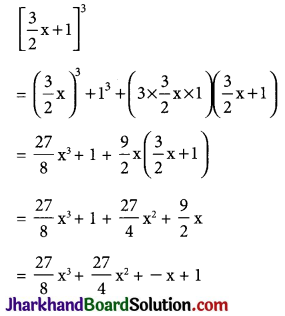
(iv) \(\left[x-\frac{2}{3} y\right]^3\)
Using identity, (a – b)3 = a3 – b3 – 3ab(a – b)
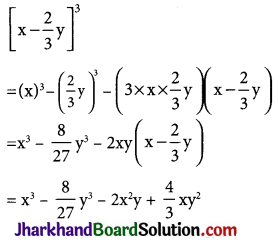
Question 7.
Evaluate the following using suitable identities:
(i) (99)3
(ii) (102)3
(iii) (998)3
Answer:
(i) (99)3 = (100 – 1)3
Using identity, (a – b)3 = a3 – b3 – 3ab(a – b)
(99)3 = (100 – 1)3
= (100)3 – (1)3 – (3 × 100 × 1) (100 – 1)
= 1000000 – 1 – 30000 + 300
= 970299

(ii) (102)3 = (100 + 2)3
Using identity, (a – b)3 = a3 – b3 – 3ab(a – b)
(100 + 2)3
= (100)3 + (2)3 + (3 × 100 × 2) (100 + 2)
= 1000000 + 8 + 600 (100 + 2)
= 1000000 + 8 + 60000 + 1200
= 1061208
(iii) (998)3 = (1000 – 2)3
Using identity, (a – b)3 = a3 – b3 – 3ab(a – b)
= (1000)3 – (2)3 – (3 × 1000 × 2) (1000 – 2)
= 1000000000 – 8 – 6000 × (1000 – 2)
= 1000000000 – 8 – 6000000 + 12000
= 1000012000 – 6000008
= 994011992
Question 8.
Factorise each of the following:
(i) 8a3 + b3 + 12a2b + 6ab2
(ii) 8a3 – b3 – 12a2b + 6ab2
(iii) 27 – 125a3 – 135a + 225a2
(iv) 64a3 – 27b3 – 144a2b + 108ab2
(v) 27p3 – \(\frac{1}{216}-\frac{9}{2}\)p2 + \(\frac {1}{4}\)p
Answer:
(i) 8a3 + b3 + 12a2b + 6ab2
Using identity, (a + b)3 = a3 + b3 + 3a2b + 3ab2
= (2a)3 + (b)3 + 3 (2a) (b) (2a + b)
= (2a + b)3
= (2a + b) (2a + b) (2a + b)
(ii) 8a3 – b3 – 12a2b + 6ab2
Using identity, (a + b)3 = a3 + b3 + 3a2b + 3ab2
= (2a)3 – (b)3 – 3 (2a)(b)(2a – b)
= (2a – b)3 = (2a – b)(2a – b)(2a – b)
(iii) 27 – 125a3 – 135a + 225a2
Using identity, (a + b)3 = a3 + b3 + 3a2b + 3ab2
= (3)3 – (5a)3 – 3(3)(5a) (3 – 5a)
= (3 – 5a)3 = (3 – 5a) (3 – 5a) (3 – 5a)
(iv) 64a3 – 27b3 – 144a2b + 108aba2
Using identity, (a + b)3 = a3 + b3 + 3a2b + 3ab2
= (4a)3 – (3b)3 – 3 (4a) (3b) (4a – 3b)
= (4a – 3b)3
= (4a – 3b) (4a – 3b) (4a – 3b)
(v) 27p3 – \(\frac{1}{216}-\frac{9}{2}\)p2 + \(\frac {1}{4}\)p
Using identity, (a + b)3 = a3 + b3 + 3a2b + 3ab2


Question 9.
Verify:
(i) x3 + y3 = (x + y) (x2 – xy + y2)
(ii) x3 – y3 = (x – y) (x2 + xy + y2)
Answer:
(i) (x + y) (x2 – xy + y2)
We know that,
(x + y)3 = x3 + y3 + 3xy(x + y)
⇒ x3 + y3 = (x + y)3 – 3xy(x + y)
⇒ x3 + y3 = (x + y)[(x + y)2 – 3xy] {Taking (x + y) common}
⇒ x3 + y3 = (x + y) (x2 + y2 – xy)
⇒ x3 + y3 = (x + y) (x2 + xy + y2)
(ii) x3 – y3 = (x – y) (x2 + xy + y2)
We know that,
(x – y)3 = x3 + y3 – 3xy(x – y)
⇒ x3 – y3 = (x – y)3 + 3xy(x – y)
⇒ x3 + y3 = (x – y)[(x – y)2 + 3xy] {Taking (x – y) common}
⇒ x3 + y3 = (x – y) [(x2 + y2 – 2xy) + 3xy]
⇒ x3 + y3 = (x + y)(x2 + y2 + xy)
Question 10.
Factorise each of the following:
(i) 27y3 + 125z3
(ii) 64m3 – 343n3
Answer:
(i) 27y3 + 125z3
Using identity, x3 + y3 = (x + y)(x2 + y2 + xy)
= (3y + 5z) [(3y)2 – 3y × 5z + (5z)2]
= (3y + 5z) [9y2 – 15yz + 25z2]
(ii) 64m3 – 343n3
Using identity, x3 + y3 = (x + y)(x2 + y2 + xy)
= (4m – 7n) [(4m)2 + 4m × 7n + (7n)2]
= (4m – 7n) [16m2 + 28mn + 49n2]
Question 11.
Factorise: 27x3 + y3 + z3 – 9xyz
Answer:
27x3 + y3 + z3 – 9xyz
= (3x)3 + y3 + z3 – 3 × (3x) yz
Using identity, x3 + y3 + z3 – 3xyz
= (x + y + z)(x2 + y2 + z2 – xy – yz – xz)
27x3 + y3 + z3 – 9xyz
= (3x + y + z) [(3x)2 + (y)2 + (z)2 – 3xy – yz – 3xz]
= (3x + y + z) (9x2 + y2 + z2 – 3xy – yz – 3xz)
Question 12.
Verify that: x3 + y3 + z3 – 3xyz = \(\frac {1}{2}\)(x + y + z) [(x – y)2 + (y – z)2 + (z – x)2]
Answer:
We know that,
x3 + y3 + z3 – 3xyz
= (x + y + z)(x2 + y2 + z2 – xy – yz – xz)
⇒ x3 + y3 + z3 – 3xyz
= \(\frac {1}{2}\) × (x + y + z) 2(x2 + y2+ z2 – xy – yz – xz)
= \(\frac {1}{2}\)(x + y + z)(2x2 + 2y2 + 2z2 – 2xy – 2yz – 2xz)
= \(\frac {1}{2}\)(x + y + z) [(x2 + y2 – 2xy) + (y2 + z2 – 2yz) + (x2 + z2 – 2xz)]
= \(\frac {1}{2}\)(x + y + z) [(x – y)2+ (y – z)2 + (z – x)2]
Question 13.
If x + y + z = 0, show that x3 + y3 + z3 = 3xyz.
Answer:
We know that,
x3 + y3 + z3
= (x2 + y2+ z2 – xy – yz – xz)
Now put (x + y + z) = 0,
(x2 + y2+ z2 – xy – yz – xz) – 3xyz = (0)(x2 + y2+ z2 – xy – yz – xz)
⇒ x3 + y3 + z3 = 3xyz

Question 14.
Without actually calculating the cubes, find the value of each of the following:
(i) (-12)3 + (7)3 + (5)3
(ii) (28)3 + (-15)3 + (-13)3
Answer:
(i) (-12)3 + (7)3 + (5)3
Let x = – 12, y = 7 and z = 5
We observed that,
x + y + z = -12 + 7 + 5 = 0
We know that if, x + y + z = 0,
then x3 + y3 + z3 = 3xyz
(-12)3 + (7)3 + (5)3 = 3(-12)(7)(5)
= – 1260
(ii) (28)3 + (-15)3 + (-13)3
Let x = 28, y = – 15 and z = – 13
We observed that,
x + y + z = 28 – 15 – 13 = 0
We know that if, x + y + z = 0,
then x3 + y3 + z3 = 3xyz
(28)3 + (-15)3 + (-13)3
= 3(28)(-15)(-13) = 16380
Question 15.
Give possible expressions for the length and breadth of each of the following rectangles, in which their areas are given:
(i) Area: 25a2 – 35a +12
(ii) Area: 35y2 + 13y – 12
Answer:
(i) Area: 25a2 – 35a +12
Since, area is product of length and breadth therefore by factorising the given area, we can know the length and breadth of rectangle.
25a2 – 35a +12 = 25a2 – 15a – 20a + 12
= 5a(5a – 3) – 4(5a – 3) = (5a – 4) (5a -3 )
Possible expression for length = 5a – 3
Possible expression for breadth = 5a – 4
(ii) Area: 35y2 + 13y – 12
35y2 + 13y – 12 = 35y2 – 15y + 28y – 12
= 5y(7y – 3) + 4(7y – 3) = (5y + 4)(7y – 3)
Possible expression for length = (5y + 4)
Possible expression for breadth = (7y – 3)

Page – 50
Question 16.
What are the possible expressions for the dimensions of the cuboids whose volumes are given below?
(i) Volume: 3x2 – 12x
(ii) Volume : 12ky2 + 8ky – 20k
Answer:
(i) Volume: 3x2 – 12x
Since, volume is product of length, breadth and height therefore by factorising the given volume, we can know the length, breadth and height of the cuboid.
3x2 – 12x = 3x(x – 4)
Possible expression for length = 3
Possible expression for breadth = x
Possible expression for height = (x – 4)
(ii) Volume : 12ky2 + 8ky – 20k
Since, volume is product of length, breadth and height therefore by factorising the given volume, we can know the length, breadth and height of the cuboid.
12ky2 + 8ky – 20k = 4k(3y2 + 2y – 5) = 4k(3y2 +5y – 3y – 5)
= 4k[y(3y + 5) – 1(3y + 5)]
= 4k (3y + 5) (y – 1)
Possible expression for length = 4k
Possible expression for breadth = (3y + 5)
Possible expression for height = (y – 1)
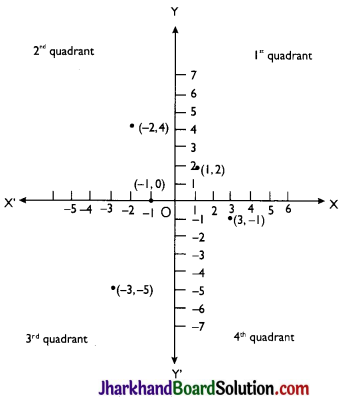
![]()
